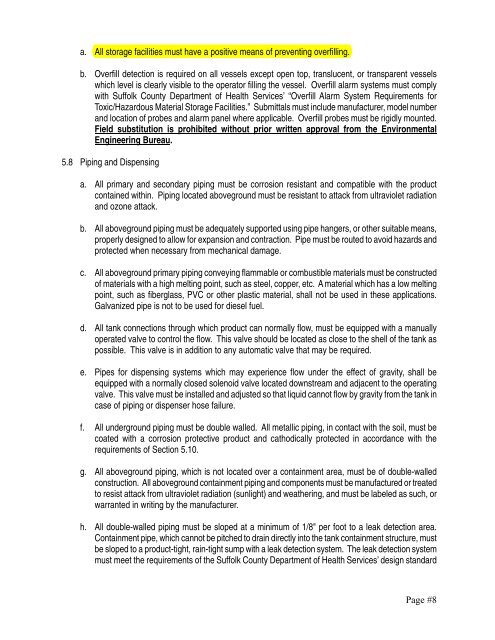Aboveground Tanks (Outdoors) - Guidelines - Brookhaven National ...
Aboveground Tanks (Outdoors) - Guidelines - Brookhaven National ...
Aboveground Tanks (Outdoors) - Guidelines - Brookhaven National ...
Create successful ePaper yourself
Turn your PDF publications into a flip-book with our unique Google optimized e-Paper software.
a. All storage facilities must have a positive means of preventing overfilling.<br />
b. Overfill detection is required on all vessels except open top, translucent, or transparent vessels<br />
which level is clearly visible to the operator filling the vessel. Overfill alarm systems must comply<br />
with Suffolk County Department of Health Services’ “Overfill Alarm System Requirements for<br />
Toxic/Hazardous Material Storage Facilities.” Submittals must include manufacturer, model number<br />
and location of probes and alarm panel where applicable. Overfill probes must be rigidly mounted.<br />
Field substitution is prohibited without prior written approval from the Environmental<br />
Engineering Bureau.<br />
5.8 Piping and Dispensing<br />
a. All primary and secondary piping must be corrosion resistant and compatible with the product<br />
contained within. Piping located aboveground must be resistant to attack from ultraviolet radiation<br />
and ozone attack.<br />
b. All aboveground piping must be adequately supported using pipe hangers, or other suitable means,<br />
properly designed to allow for expansion and contraction. Pipe must be routed to avoid hazards and<br />
protected when necessary from mechanical damage.<br />
c. All aboveground primary piping conveying flammable or combustible materials must be constructed<br />
of materials with a high melting point, such as steel, copper, etc. A material which has a low melting<br />
point, such as fiberglass, PVC or other plastic material, shall not be used in these applications.<br />
Galvanized pipe is not to be used for diesel fuel.<br />
d. All tank connections through which product can normally flow, must be equipped with a manually<br />
operated valve to control the flow. This valve should be located as close to the shell of the tank as<br />
possible. This valve is in addition to any automatic valve that may be required.<br />
e. Pipes for dispensing systems which may experience flow under the effect of gravity, shall be<br />
equipped with a normally closed solenoid valve located downstream and adjacent to the operating<br />
valve. This valve must be installed and adjusted so that liquid cannot flow by gravity from the tank in<br />
case of piping or dispenser hose failure.<br />
f. All underground piping must be double walled. All metallic piping, in contact with the soil, must be<br />
coated with a corrosion protective product and cathodically protected in accordance with the<br />
requirements of Section 5.10.<br />
g. All aboveground piping, which is not located over a containment area, must be of double-walled<br />
construction. All aboveground containment piping and components must be manufactured or treated<br />
to resist attack from ultraviolet radiation (sunlight) and weathering, and must be labeled as such, or<br />
warranted in writing by the manufacturer.<br />
h. All double-walled piping must be sloped at a minimum of 1/8" per foot to a leak detection area.<br />
Containment pipe, which cannot be pitched to drain directly into the tank containment structure, must<br />
be sloped to a product-tight, rain-tight sump with a leak detection system. The leak detection system<br />
must meet the requirements of the Suffolk County Department of Health Services’ design standard<br />
Page #8
















